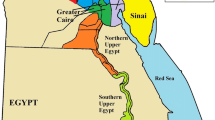Abstract
Population data of the Aymara in the province of Puno were established for 23 autosomal STR markers. DNA was obtained from unrelated individuals (n = 190) who reside in three areas of the Floating Islands of Lake Titicaca, residents on the border with Bolivia and residents who are not from the border with Bolivia. The PENTA E marker presented the highest PD (0.9738), PIC (0.8793), and PM (0.7847) values. The combined PD was greater than 0.99999999 and the combined PE was 0.99999994. The largest distance, based on Fst values, was between the Aymara population and the Ashaninca population (0.04022), and the smallest distance was with the populations of Bolivia (0.00136) and Peru (0.00525).
Similar content being viewed by others
References
Moretti T, Moreno L, Smerick J, Pignone M, Hizon R, Buckleton J, Bright J, Onorato A (2016) Population data on the expanded CODIS core STR loci for eleven populations of significance for forensic DNA analyses in the United States. Forensic Sci Int Genet 25:175–181. https://doi.org/10.1016/j.fsigen.2016.07.022
Delgado E, Neyra CD (2018) Frecuencias alélicas de 21 marcadores STR autosómicos en una población mestiza peruana aplicado a la práctica forense. Rev Esp Med Legal 45:92–97. https://doi.org/10.1016/j.reml.2018.09.002
Neyra CD, Suarez M, Cueva E, Bailón H, Gutierrez E (2019) Identificación genética de recién nacidos en Perú: un estudio piloto. Rev Chil Pediatr 90(1):26–35. https://doi.org/10.32641/rchped.v90i1.730
Neyra Rivera CD, Delgado Ramos E, Robles Mamani CS, Velasquez Reinoso MRE, Caceres Rey OA, Budowle B (2020) Population genetic study of a Peruvian population using human identification STRs. Int J Legal Med. https://doi.org/10.1007/s00414-020-02418-6
Instituto Nacional de Desarrollo de Pueblos Andinos, Amazónicos y Afroperuanos (INDEPA) (2010) Mapa etnolingüístico del Perú. Rev Peru Med Exp Salud Publica 27(2):288–291. https://doi.org/10.17843/rpmesp.2010.272.1477
Instituto Nacional de Estadística e Informática (INEI). Perú: Perfil Sociodemográfico Informe Nacional Censos Nacionales 2017: XII de Población, VII de Vivienda y III de Comunidades Indigenas [Internet]. Lima: INEI; 2018 [revised 2017-2018; cited 2020 Sep 04]. Available from: https://www.inei.gob.pe/media/MenuRecursivo/publicaciones_digitales/Est/Lib1539/
Instituto Nacional de Estadística e Informática (INEI). PERÚ-BOLIVIA Perfil Sociodemográfico y Económico de los Distritos y Municipios Fronterizos, 2015. Lima: INEI, 2015 [revised 2015; cited 2020 Sep 04]. Available from: https://www.inei.gob.pe/media/MenuRecursivo/publicaciones_digitales/Est/Lib1383/index.html
Córdova J, Fujita R, Sandoval J, Descailleaux J, Velásquez M, Távara C, Barletta C (2011) Divergencia genética en poblaciones peruanas detectada a partir de las frecuencias haplotípicas del mtDNA y del gen nuclear MBL. An Fac Med 72(1):51–59. https://doi.org/10.15381/anales.v72i1.1103
Acosta O, Solano L, Huerta D, Oré D, Sandoval J, Figueroa J (2012) Variabilidad genética de la respuesta inflamatoria. I. Polimorfismo -511 C/T en el gen IL1β en diferentes subpoblaciones peruanas. An Fac Med 3:221–225. https://doi.org/10.15381/anales.v73i3.868
Bisso-Machado R, Ramallo V, Paixao-Cortes V, Acuna-Alonzo V, Demarchi D, Sandoval J, Granara A, Salzano F, Hunemeier T, Bortolini M (2016) NAT2 gene diversity and its evolutionary trajectory in the Americas. Pharm J 16(6):559–565. https://doi.org/10.1038/tpj.2015.72
Córdova JH, Fujita R, Sandoval J, Velásquez M, Távara C, Cotos D, Vásquez J, Barletta C, Descailleaux J (2008) Poblamiento del continente americano y del Perú sugerido de un análisis filogeográfico de haplogrupos del mtDNA en etnias nativas. I: inferencias primarias. Arch Biol Andina 14(1):23–39
Sandoval J, Salazar-Granara A, Acosta O, Castillo-Herrera W, Fujita R, Pena S, Santos F (2013) Tracing the genomic ancestry of Peruvians reveals a major legacy of pre-Columbian ancestors. J Hum Genet 58(9):627–634. https://doi.org/10.1038/jhg.2013.73
Tereba A (1999) Tools for analysis of population statistics. Profiles DNA 2:3–5
Excoffier L, Laval G, Schneider S (2005) Arlequin (version 3.0): an integrated software package for population genetics data analysis. Evol Bioinformatics Online 1:47–50
Rocabado O, García O, Yurrebaso I, Inda F, Taboada P (2009) Population genetic data for 15 STR loci (Identifiler™ kit) in Bolivia. Legal Med 11(6):302–304
Tineo DH (2017) Caracterización genética de una muestra poblacional ashaninka en el distrito de Puerto Bermúdez, Pasco- Perú, empleando marcadores STR autosómico y del cromosoma Y [Tesis de Maestría]. Universidad Nacional Mayor de San Marcos, Lima
Hill C, Duewer D, Kline M, Coble M, Butler J (2013) US population data for 29 autosomal STR loci. Forensic Sci Int Genet 7(3):e82–e83
Foissac A, Crouau R, Fauré S, Thomsen M, Cambon-Thomsen A (1997) Microsatellites in the HLA región: an overview. Tissue Antigens 49:197–214. https://doi.org/10.1111/j.1399-0039.1997.tb02740.x
Budowle B, Shea B, Niezgoda S, Chakraborty R (2001) CODIS STR loci data from 41 sample populations. J Forensic Sci 46(3):453–489
De la Cruz AF (2006) Análisis de la variabilidad genética en una muestra poblacional de la provincia de Andahuaylas–Apurímac, Perú–con los marcadores microsatélites TPOX
Acknowledgments
We especially would like to thank the National Institute of Health for the facilities and equipment for the research.
Author information
Authors and Affiliations
Corresponding author
Ethics declarations
Ethical approval
The study was approved by the ethics committee of Instituto de Medicina Tropical “Daniel Alcides Carrion” from Universidad Nacional Mayor de San Marcos (Certificate of Approval CIEI-2018-015).
Conflict of interest
The authors declare that they have no conflict f interest.
Additional information
Publisher’s note
Springer Nature remains neutral with regard to jurisdictional claims in published maps and institutional affiliations.
Rights and permissions
About this article
Cite this article
Neyra-Rivera, C.D., Ticona Arenas, A., Delgado Ramos, E. et al. Allelic frequencies with 23 autosomic STRS in the Aymara population of Peru. Int J Legal Med 135, 779–781 (2021). https://doi.org/10.1007/s00414-020-02448-0
Received:
Accepted:
Published:
Issue Date:
DOI: https://doi.org/10.1007/s00414-020-02448-0




